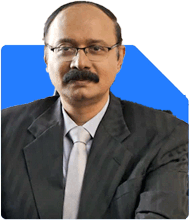40-Year-Old Seeking Investment Advice With Income and Rental Property
Ramalingam Kalirajan |10906 Answers |Ask -Follow
Mutual Funds, Financial Planning Expert - Answered on Jul 15, 2024
He has an MBA in finance from the University of Madras and is a certified financial planner.
He is the director and chief financial planner at Holistic Investment, a Chennai-based firm that offers financial planning and wealth management advice.... more

I am 40 years old lady working on private firm. I have salary 1.5 lacs(excluding tax) per month and monthly expenditure is 50k. I have my property rented out and per month income is 30k. Loan is nil. I have not done any investment till now except FD around 35Lacs and PF. It might be already late to start now but Can you guide me for investment options considering 5 more years of my job.
Existing Investments
You have Rs 35 lakhs in a fixed deposit and provident fund contributions. Fixed deposits are safe but offer lower returns. Diversifying your investments can yield better results.
Financial Goals
It's important to define your financial goals. Given you have five more years of work, your primary goals might include building a retirement corpus, creating an emergency fund, and perhaps saving for other personal aspirations.
Investment Options
Now, let's explore suitable investment options. We'll focus on those that offer a balance between safety, growth, and liquidity.
Mutual Funds
Benefits of Actively Managed Funds
Mutual funds are a versatile investment option. Actively managed funds are managed by professional fund managers who aim to outperform the market. These funds offer potential for higher returns compared to passive funds like index funds.
Types of Mutual Funds
Equity Mutual Funds: These funds invest in stocks. They have the potential for high returns but come with higher risk. Given your five-year horizon, a mix of large-cap, mid-cap, and multi-cap funds could be beneficial.
Debt Mutual Funds: These funds invest in fixed-income securities. They are less risky than equity funds and provide regular income. Consider short-term or ultra-short-term debt funds for liquidity and stability.
Hybrid Mutual Funds: These funds invest in both equity and debt instruments. They offer a balance of risk and return. Conservative hybrid funds can be a good option for stability and growth.
Systematic Investment Plan (SIP)
SIP is a disciplined way to invest in mutual funds. It allows you to invest a fixed amount regularly. SIPs average out market volatility and help in building a corpus over time. Given your surplus of Rs 1.3 lakhs, you can allocate a portion to SIPs.
Public Provident Fund (PPF)
PPF is a government-backed scheme with attractive interest rates and tax benefits. It's a long-term investment with a lock-in period of 15 years. However, partial withdrawals are allowed after five years. PPF is a safe option for building a retirement corpus.
National Pension System (NPS)
NPS is a retirement-focused investment. It offers tax benefits and helps build a substantial corpus for retirement. NPS invests in a mix of equity, corporate bonds, and government securities, providing a balanced risk-return profile.
Gold
Investing in gold is a traditional and safe option. It acts as a hedge against inflation and currency fluctuations. You can invest in gold ETFs or sovereign gold bonds instead of physical gold for better liquidity and safety.
Diversified Equity Funds
These funds invest across various sectors and market capitalizations. They provide diversification and reduce risk compared to sector-specific funds. Given your five-year horizon, diversified equity funds can offer substantial growth potential.
Emergency Fund
An emergency fund is essential for financial security. It should cover 6-12 months of living expenses. With your monthly expenditure of Rs 50,000, aim for an emergency fund of Rs 3-6 lakhs. Keep this fund in a liquid or ultra-short-term debt fund for easy access.
Tax Planning
Tax planning is crucial to maximize your returns. Utilize tax-saving instruments under Section 80C and Section 80D.
Section 80C
ELSS Funds: Equity Linked Savings Schemes (ELSS) offer tax benefits and have a lock-in period of three years. They invest in equities and provide potential for high returns.
PPF: Contributions to PPF are tax-deductible and the interest earned is tax-free.
Section 80D
Invest in health insurance for yourself and your family. Premiums paid are eligible for tax deductions. Health insurance safeguards against unexpected medical expenses.
Regular Review and Rebalancing
Regularly review your investment portfolio to ensure it aligns with your goals. Rebalancing involves adjusting your portfolio to maintain the desired asset allocation. This helps manage risk and optimize returns.
Annual Review
Conduct an annual review of your investments. Assess performance, evaluate fund managers, and make necessary adjustments. This ensures your investments stay on track.
Rebalancing Strategy
Rebalancing is essential to maintain your risk tolerance. If equities outperform, their proportion in your portfolio increases. Sell some equities and invest in debt to restore balance. This strategy helps manage market volatility.
Avoiding Common Pitfalls
Emotional Investing
Avoid making investment decisions based on emotions. Market volatility can trigger fear and greed. Stick to your investment plan and make decisions based on logic and analysis.
Chasing Returns
Don't chase high returns by investing in high-risk assets without understanding them. Balanced and well-researched investments yield better long-term results.
Ignoring Inflation
Inflation erodes the purchasing power of money. Ensure your investments grow faster than inflation. Equity investments typically outperform inflation over the long term.
Lack of Diversification
Diversification reduces risk. Don't put all your money in one type of investment. Spread it across various asset classes to balance risk and return.
Benefits of Professional Guidance
A Certified Financial Planner (CFP) can provide personalized advice. They help align your investments with your financial goals, risk tolerance, and time horizon. Their expertise ensures a comprehensive financial plan.
Comprehensive Financial Planning
A CFP offers holistic financial planning. They consider all aspects of your financial life, including investments, insurance, tax planning, and retirement planning.
Tailored Investment Strategy
CFPs tailor investment strategies to your unique needs. They help choose suitable funds, allocate assets, and plan for future financial goals.
Monitoring and Adjusting
CFPs monitor your investments and suggest adjustments as needed. They ensure your portfolio remains aligned with your goals and market conditions.
Final Insights
Starting your investment journey at 40 is not too late. With a strategic plan, you can build a secure financial future. Focus on a mix of equity and debt investments, utilize tax-saving options, and maintain an emergency fund. Regularly review and adjust your portfolio to stay on track. Seek professional guidance for tailored advice and comprehensive financial planning. By taking these steps, you can achieve financial security and peace of mind.
Best Regards,
K. Ramalingam, MBA, CFP,
Chief Financial Planner,
www.holisticinvestment.in
You may like to see similar questions and answers below
Ramalingam Kalirajan |10906 Answers |Ask -Follow
Mutual Funds, Financial Planning Expert - Answered on Jul 12, 2024
Ramalingam Kalirajan |10906 Answers |Ask -Follow
Mutual Funds, Financial Planning Expert - Answered on Jul 25, 2024
Ramalingam Kalirajan |10906 Answers |Ask -Follow
Mutual Funds, Financial Planning Expert - Answered on Jun 05, 2025
Ramalingam Kalirajan |10906 Answers |Ask -Follow
Mutual Funds, Financial Planning Expert - Answered on Dec 19, 2025
Nayagam P P |10859 Answers |Ask -Follow
Career Counsellor - Answered on Dec 19, 2025
Ramalingam Kalirajan |10906 Answers |Ask -Follow
Mutual Funds, Financial Planning Expert - Answered on Dec 19, 2025
Ramalingam Kalirajan |10906 Answers |Ask -Follow
Mutual Funds, Financial Planning Expert - Answered on Dec 19, 2025
Ramalingam Kalirajan |10906 Answers |Ask -Follow
Mutual Funds, Financial Planning Expert - Answered on Dec 19, 2025
Radheshyam Zanwar |6751 Answers |Ask -Follow
MHT-CET, IIT-JEE, NEET-UG Expert - Answered on Dec 19, 2025
Radheshyam Zanwar |6751 Answers |Ask -Follow
MHT-CET, IIT-JEE, NEET-UG Expert - Answered on Dec 19, 2025
Samraat Jadhav |2514 Answers |Ask -Follow
Stock Market Expert - Answered on Dec 18, 2025
Reetika Sharma |432 Answers |Ask -Follow
Financial Planner, MF and Insurance Expert - Answered on Dec 18, 2025
Reetika Sharma |432 Answers |Ask -Follow
Financial Planner, MF and Insurance Expert - Answered on Dec 18, 2025
























